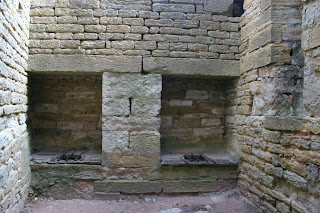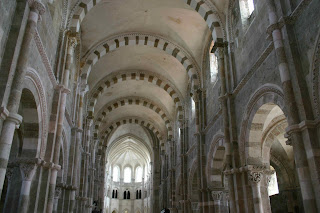All societies have to figure out what to do with the end-products of digestion. We're not cows, who just let it fly wherever they are, or dogs, who won't foul their own den but consider the outdoors their rightful place to do what needs to be done (including making a scent-statement for other dogs).
(Interesting side point: if beings from another planet were watching dog-walkers, and noticed that the dogs being walked just did what they wanted, while the humans cleaned up after them, who would the aliens decide was the true Master?)
The Middle Ages had chamber pots and latrines. We have no idea how lucky we are to have city sewers and septic systems. Push the flush lever, and you never have to think about it again. Medieval people didn't have it so easy. They preferred not to think about such things, but being clean and odor-free was a lot harder.
On a farm, the manure pile would serve for the family's use as well. In a town house, there would often be a privy in the back yard, built over a deep hole. In a castle, there generally wasn't a handy manure pile, and you didn't really have the option of stepping out of the building. (In fact the stables would have a manure pile, but the number of humans living in a castle would overwhelm the pile's ability to absorb human waste along with that of the horses. And castle folk thought of themselves as much more refined than to use the manure pile anyway.)
Castles had latrines, located off main rooms, where one could go to do one's business and where chamber pots could be dumped. They were rather discreetly located, and there were generally different sets for the noble family and for the warriors and workers.
Latrines might be built in the outer walls, letting things dribble down the wall, but from the thirteenth century onward castle builders were very careful not to put the latrines in any sort of defensible wall. Everyone remembered what happened at Château Gaillard in Normandy (pictured below), where the attackers got into the castle by climbing up through the latrines.
In addition of course no one wanted their castle to be stinky, so things dribbling down a wall, especially an interior wall, would be frequently cleaned. One sometimes hears that a castle's moat functioned as a sewer, but this is not true, although it would certainly not be savory. Being surrounded by a sewer was not something any medieval lord would put up with (besides, most castles didn't have moats).
Alternately, a cesspit could be constructed within a wall. It would be made with an easy way to clean it out. Cesspits became the standard in cities during the early modern period, when urban growth made the backyard with its privy an expensive use of real estate.
The stench of a badly maintained latrine or cesspit was considered theologically a reminder of the weakness of human flesh, something that evoked both death and the powers of evil. Miracle stories are full of demons lurking in latrines and emitting foul odors.
The picture below shows a high-end two-seater in a fourteenth-century castle.
Miscellaneous fun fact: There is no actual name for that big white porcelain thing in the bathroom that is neither a sink nor a tub. Americans usually call it a "toilet," but this is a euphemism. It used to be that people would "make their toilet," meaning comb, brush, put on makeup, get properly dressed, and someone "stepping away" would be said to be going to the "toilet room," even if they were already dressed and brushed. The Brits still call the room, not the fixture, the toilet. ("Toilet water," mild perfume, still keeps the original meaning, in spite of a lot of adolescent sniggering.)
Brits call the fixture the "loo," a shortening of "lavabo," but that means sink, a place to wash up. Or they call it a WC, short for "water closet," the small room (closet) with plumbing. You will also see the term WC on the Continent. The Germans may even refer to the "wasser," but that just means water. You may see the term "commode," which is French for useful--an arch way of saying you need to use the "useful object." Even more arch is the term "facilities," as in "the facilities of modern civilization."
Even the room is referred to euphemistically. "I have to go to the bathroom." You need to take a bath? Really? "The ladies' room." "The gentlemen's room." No indication in the term of what the ladies and gentlemen will be up to. I had a teacher in elementary school who referred to the "cloakroom," though no cloaks were involved.
© C. Dale Brittain 2017
For more on medieval hygiene, see my ebook, Positively Medieval: Life and Society in the Middle Ages, available from Amazon and other ebook platforms.
Monday, October 30, 2017
Tuesday, October 3, 2017
Medieval travel and tourism
When people today are asked about retirement plans, they very frequently say, "I hope to travel." Being a tourist, traveling around to interesting places, is considered fun and worthwhile, even if only really available to those with leisure time (one wonders if those whose jobs require a great deal of travel have the same attitude toward retirement).
As I have discussed previously, travel in the Middle Ages was a lot harder than it is now. With human power (walking) the chief form of transport, much of the population might spend most of their lives within a twenty-mile radius. Horses were for the well to do, and carts, made to transport goods, would have been very uncomfortable to ride in over any distance.
Yet people did travel. The aristocracy especially traveled a lot. It was easier to move people than to move food, so large courts would frequently move from place to place, eating up the food at one palace before moving on to the next. Without modern communication, the only easy way to tell what was happening somewhere was to go there, so kings, dukes, counts, and landlords were constantly on the move, checking things out, passing judgments, hearing complaints, collecting revenue. And of course you had armies marching back and forth and young men traveling to tournaments.
Tourism as we know it did not exist in the Middle Ages. Our version really began in the nineteenth century, when well to do young men (rarely women) would undertake a Grand Tour. Young English gentlemen would travel around the Continent for months, even a few years, picking up culture and art, admiring the scenery, and visiting places of historical significance. The very word "tourism" comes from taking the Tour.
But modern tourism essentially began with the automobile, after World War I. It is much, much easier to go visit interesting places when one can hop in the car. In France, after the Armistice, people wanted to visit the battlefields where so many of their young men had died. The automobile made this possible, and Michelin especially (maker of car tires) started putting out helpful booklets to let people figure out where to go and what to see.
So modern tourism is a combination of "broadening one's mind" by being exposed to different scenes and ideas, of entertainment by seeing lovely and interesting places, and of education, by learning about history and other useful subjects. The museums where all this educational information was made available developed along with tourism.
Something that looks like tourism certainly existed in the Middle Ages, but its purpose was very different from broadening one's mind or being entertained or educated. It was called pilgrimage.
One traveled places to improve one's soul, and the difficulties of the journey were supposed to help improve it, by shaking one out of lethargy or luxury. The best pilgrimage goal was always Jerusalem, the scene of the Crucifixion, but most Europeans would choose more accessible places to go.
Rome was always a place for pilgrims, full of the bones of early martyrs, the graves of Saints Peter and Paul, and of course the papacy. Many other spots became pilgrimage centers, from Vézelay in Burgundy (pictured above) to Santiago in northern Spain (and a pilgrimage route ran between these two). Pilgrims were always interested in lovely architecture, important relics, and holy men (hermits could be visited as part of the pilgrim experience), but they do not seem to have paid as much attention to scenery.
© C. Dale Brittain 2017
For more on medieval travel, see my ebook, Positively Medieval: Life and Society in the Middle Ages.
As I have discussed previously, travel in the Middle Ages was a lot harder than it is now. With human power (walking) the chief form of transport, much of the population might spend most of their lives within a twenty-mile radius. Horses were for the well to do, and carts, made to transport goods, would have been very uncomfortable to ride in over any distance.
Yet people did travel. The aristocracy especially traveled a lot. It was easier to move people than to move food, so large courts would frequently move from place to place, eating up the food at one palace before moving on to the next. Without modern communication, the only easy way to tell what was happening somewhere was to go there, so kings, dukes, counts, and landlords were constantly on the move, checking things out, passing judgments, hearing complaints, collecting revenue. And of course you had armies marching back and forth and young men traveling to tournaments.
Tourism as we know it did not exist in the Middle Ages. Our version really began in the nineteenth century, when well to do young men (rarely women) would undertake a Grand Tour. Young English gentlemen would travel around the Continent for months, even a few years, picking up culture and art, admiring the scenery, and visiting places of historical significance. The very word "tourism" comes from taking the Tour.
But modern tourism essentially began with the automobile, after World War I. It is much, much easier to go visit interesting places when one can hop in the car. In France, after the Armistice, people wanted to visit the battlefields where so many of their young men had died. The automobile made this possible, and Michelin especially (maker of car tires) started putting out helpful booklets to let people figure out where to go and what to see.
So modern tourism is a combination of "broadening one's mind" by being exposed to different scenes and ideas, of entertainment by seeing lovely and interesting places, and of education, by learning about history and other useful subjects. The museums where all this educational information was made available developed along with tourism.
Something that looks like tourism certainly existed in the Middle Ages, but its purpose was very different from broadening one's mind or being entertained or educated. It was called pilgrimage.
One traveled places to improve one's soul, and the difficulties of the journey were supposed to help improve it, by shaking one out of lethargy or luxury. The best pilgrimage goal was always Jerusalem, the scene of the Crucifixion, but most Europeans would choose more accessible places to go.
Rome was always a place for pilgrims, full of the bones of early martyrs, the graves of Saints Peter and Paul, and of course the papacy. Many other spots became pilgrimage centers, from Vézelay in Burgundy (pictured above) to Santiago in northern Spain (and a pilgrimage route ran between these two). Pilgrims were always interested in lovely architecture, important relics, and holy men (hermits could be visited as part of the pilgrim experience), but they do not seem to have paid as much attention to scenery.
© C. Dale Brittain 2017
For more on medieval travel, see my ebook, Positively Medieval: Life and Society in the Middle Ages.
Subscribe to:
Posts (Atom)




